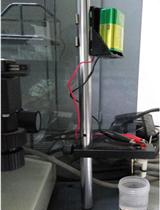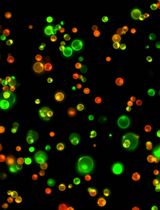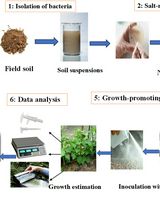- EN - English
- CN - 中文
MAMP-triggered Medium Alkalinization of Plant Cell Cultures
MAMP诱导植物细胞培养基质碱化
发布: 2020年04月20日第10卷第8期 DOI: 10.21769/BioProtoc.3588 浏览次数: 4597
评审: Zhibing LaiYingnan HouShweta Panchal
Abstract
Plants recognize a wide variety of microbial molecules to detect and respond to potential invaders. Recognition of Microbe-Associated Molecular Patterns (MAMPs) by cell surface receptors initiate a cascade of biochemical responses that include, among others, ion fluxes across the plasma membrane. A consequence of such event is a decrease in the concentration of extracellular H+ ions, which can be experimentally detected in plant cell suspensions as a shift in the pH of the medium. Thus, similarly to reactive oxygen species (ROS) accumulation, phosphorylation of MAP kinases and induction of defense-related genes, MAMP-induced medium alkalinization can be used as a proxy for the activation of plant immune responses. Here, we describe a detailed protocol for the measurement of medium alkalinization of tobacco BY-2 cell suspensions upon treatment with two different MAMPs: chitohexamers derived from fungal cell walls (NAG6; N-acetylglucosamine) and the flagellin epitope flg22, found in the bacterial flagellum. This method provides a reliable and fast platform to access MAMP-Triggered Immunity (MTI) in tobacco cell suspensions and can be easily adapted to other plant species as well as to other MAMPs.
Keywords: Plant immunity (植物免疫)Background
Throughout evolution, plants developed the ability to detect microbe-derived molecules and mount immune responses that seize detrimental interactions (Boutrot and Zipfel, 2017). The microbial-associated molecular patterns (MAMPs) that induce such immune responses are often broadly conserved structural components of microbes, such as chitin from fungi and flagellin from bacteria (Cook et al., 2015). Recognition of MAMPs by extracellular plant receptors leads to MAMP-triggered immunity (MTI), which contributes to halt microbial invaders and maintain plant health (Böhm et al., 2014).
At the molecular level, MAMP perception is followed by an orchestrated set of biochemical events. Firstly, within seconds to few minutes, influx of Ca2+ and H+ ions occurs, leading to membrane depolarization and extracellular alkalinization (Ranf et al., 2011). Subsequently, production of reactive oxygen species (ROS) is observed, which may locally block pathogen growth and mediate downstream signaling (Bigeard et al., 2015). Phosphorylation of MAP kinases occurs within minutes after MAMP perception and promotes transcriptional activation of defense-related genes, many of which encode antimicrobial proteins or enzymes involved in the synthesis of hormones and secondary metabolites (Bigeard et al., 2015). Lastly, accumulation of antimicrobial compounds and callose deposition are observed, further hampering microbial growth and spread.
Mechanistic understanding of the plant immune system and its activity in plant-microbe interactions has advanced through methods that monitor many of the biochemical events underlying MTI. The most widely used experimental approaches are based on detection of ROS burst, MAP kinase activation, induction of defense-related marker genes and medium alkalinization of cell suspensions (Flury et al., 2013; Bisceglia et al., 2015; Liu et al., 2018). ROS measurement is typically performed by means of luminol-based chemiluminesce assays. MAP kinase activation is detected by western blots using specific antibodies. Transcriptional reprogramming is usually accessed by monitoring the expression levels of one or a few marker genes using real-time PCR. Medium alkalinization assays are based on recording the pH changes in MAMP-treated plant cell suspensions over time using a pH sensor for small volumes. Compared to the other methods, medium alkalinization assays are less laborious and require low cost laboratory equipment. Both model plant species and crops have been studied using medium alkalinization assays (Nühse et al., 2000; Moroz et al., 2017).
Materials and Reagents
- 12-well cell culture plate (Greiner Bio-One, CELLSTAR®, catalog number: 665180 )
- Serological pipette without tip 10 ml (SARSTEDT, catalog number: 86.1688.010 )
- P200 pipette tips
- 20 ml syringe (VWR, catalog number: 613-2046 )
- 0.22 µm syringe filter (GE Healthcare, WhatmanTM Uniflo, catalog number: 9915-2502 )
- Hexa-N-acetylchitohexaose (two manufacturers are recommended: Santa Cruz Biotechnology, catalog number: sc-222018 ; Isosep, catalog number: 56/11-0010 ). Store at -20 °C
Note: Chitoheptaose (NAG7) and chitooctaose (NAG8) or even chitin (Sigma, catalog number: C7170) may be used instead of chitohexaose. - Flagellin 22 peptide (flg22: QRLSTGSRINSAKDDAAGLQIA) (Genscript, catalog number: RP19986 ). Store at -20 °C
- Gamborg’s vitamin Solution 1,000x (sterile) (Sigma-Aldrich, catalog number: G1019-50ML ). Store at 4 °C
Note: Before using, inspect for the presence of precipitates. If present, warm the solution up to 42 °C and vortex until all precipitates dissolve. - Murashige and Skoog Basal salt mixture (PhytoTechnology Laboratories, catalog number: M524 ). Store at 4 °C
- Sucrose (Sigma-Aldrich, catalog number: S5391 )
- Myo-inositol (Sigma-Aldrich, catalog number: I7508 )
- Thiamine hydrochloride (Sigma-Aldrich, catalog number: T1270 ). Store at 4 °C
- KH2PO4 (Sigma-Aldrich, catalog number: P5655 )
- Tryptone (Oxoid, catalog number: LP0042 )
- 2,4-Dichlorophenoxyacetic acid (Sigma-Aldrich, catalog number: D7299 )
- 2-(N-Morpholino)ethanosulfonic acid (MES) hydrate (Sigma-Aldrich, catalog number: M2933 )
- Kinetin (Sigma-Aldrich, catalog number: K0753 )
- Chitohexamers (NAG6) solution (see Recipes)
- Flg22 solution (see Recipes)
- Kinetin stock solution (1,000x) (see Recipes)
- 2,4-Dichlorophenoxyacetic acid (2,4-D) stock solution (1,000x) (see Recipes)
- KH2PO4 stock solution (see Recipes)
- Thiamine/myo-inositol stock solution (see Recipes)
- Tryptone stock solution (10%) (see Recipes)
- MES/Phosphate-buffered culture medium (see Recipes)
- Subculturing medium (see Recipes)
Equipment
- 125 ml Erlenmeyer flasks (PyrexTM, catalog number: 15685767 )
- 250 ml Erlenmeyer flasks (PyrexTM, catalog number: 11902619 )
- P200 adjustable pipette
- Flow hood (Thermo Scientific, model: 1300 Series Class II , catalog number: 1323TS )
- Autoclave (VWR, catalog number: 481-0666 )
- pH meter (Mettler Toledo, Seven Compact S220 Basic, catalog number: 30019028 ). Alternative models may be used as long as the pH resolution is at least 0.001
- pH sensor InLab Micro for small volumes (Mettler Toledo, catalog number: 51343160 )
- Orbital shaker (LaboTech, model: RS150 )
Software
- Microsoft Excel
- EasyDirectTM pH Software (Mettler Toledo, 30323214)
Procedure
文章信息
版权信息
© 2020 The Authors; exclusive licensee Bio-protocol LLC.
如何引用
Fiorin, G. L., Sánchez-Vallet, A., Thomma, B. P. H. J., Pereira, G. A. G. and Teixeira, P. J. (2020). MAMP-triggered Medium Alkalinization of Plant Cell Cultures. Bio-protocol 10(8): e3588. DOI: 10.21769/BioProtoc.3588.
分类
植物科学 > 植物免疫 > 宿主-细菌相互作用
植物科学 > 植物生物化学 > 其它化合物
细胞生物学 > 基于细胞的分析方法 > 离子分析 > 氢
您对这篇实验方法有问题吗?
在此处发布您的问题,我们将邀请本文作者来回答。同时,我们会将您的问题发布到Bio-protocol Exchange,以便寻求社区成员的帮助。
提问指南
+ 问题描述
写下详细的问题描述,包括所有有助于他人回答您问题的信息(例如实验过程、条件和相关图像等)。
Share
Bluesky
X
Copy link














